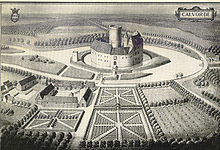Niederungsburg
The term Niederungsburg (also called Flachlandburg or Tieflandburg ) refers to castles based on the topographical castle typology , which are located in the lowlands or in a valley floor . They are fundamentally differentiated from the hilltop castles that are built on natural hills. In Germany about 34 percent of the documented castle complexes are low-rise castles.
Since low castles do not have the defensive advantage of a natural altitude, other easily defendable building sites were chosen, such as river or lake islands or marshland. In the absence of such natural obstacles, artificial approach obstacles such as water-filled or dry trenches , ramparts , palisades and circular walls became more important. For the elevation in relation to the surrounding area, artificial earthfills were created (as with the Motte ), and defense towers also served this purpose.
The early medieval complexes (including Slavic and Saxon castles) often have a narrow, deep moat and high and steep earth walls.
Naturally, low-lying castles are found mainly in lowlands , for example in the North German lowlands or in the Netherlands . But low castles were also occasionally built in mountainous landscapes, for example in the valley as an island castle on a river island (for example Pfalzgrafenstein Castle ).
Types
- Wasserburg : Generic term for all types of castles that use water as an obstacle to approach.
Based on their topographical location, low castles can be further subdivided into:
- River castle : Castle built on a river bank, usually also surrounded by moats that are fed by river water.
- Uferburg : Castle on a seashore or a lake. As with the river castle, artificial ditches usually create a connection to the water.
- Inselburg : Castle on a natural or, more rarely, an artificial island in a river or lake.
- Marsh Castle : castle in a swamp - or moorland . They used the natural inaccessibility of the site as a defensive advantage.
- Talburg : Castle in the bottom of a valley.
A special form are so-called dams , in which weir systems in the valley are connected by walls with hillside or summit castles, so that this type of castle is a combination of hill and low castle. An example of this are the castles of Bellinzona .
Naming according to the function:
- Bridge castle : A castle for monitoring and securing a river crossing.
- Hafenburg : A castle that was created to protect a harbor .
Examples
Germany:
- Nassenfels Castle
- Groß Raden , an early medieval Slavic island castle
- Dankwarderode Castle , state castle of the Brunswick dukes
Great Britain:
- Caerlaverock Castle , water castle with a triangular floor plan, Scotland
- Eilean Donan Castle , restored island castle, Scotland
- Warwick Castle , River Castle, England
Other countries:
- Beersel Castle , late medieval brick castle , Belgium
- Ordensburg Marienburg , seat of the Teutonic Order and largest brick building in Europe, Poland
- Sully-sur-Loire castle, moated castle in the Loire Valley, France
literature
- Horst Wolfgang Böhme : Niederungsburg. In: Horst Wolfgang Böhme, Reinhard Friedrich, Barbara Schock-Werner (Hrsg.): Dictionary of castles, palaces and fortresses . Reclam, Stuttgart 2004, ISBN 3-15-010547-1 , p. 156, doi: 10.11588 / arthistoricum.535 .
- Friedrich-Wilhelm Krahe: Castles and residential towers of the German Middle Ages. Volume 1. Thorbecke, Stuttgart 2002, ISBN 3-7995-0104-5 , pp. 21-23


